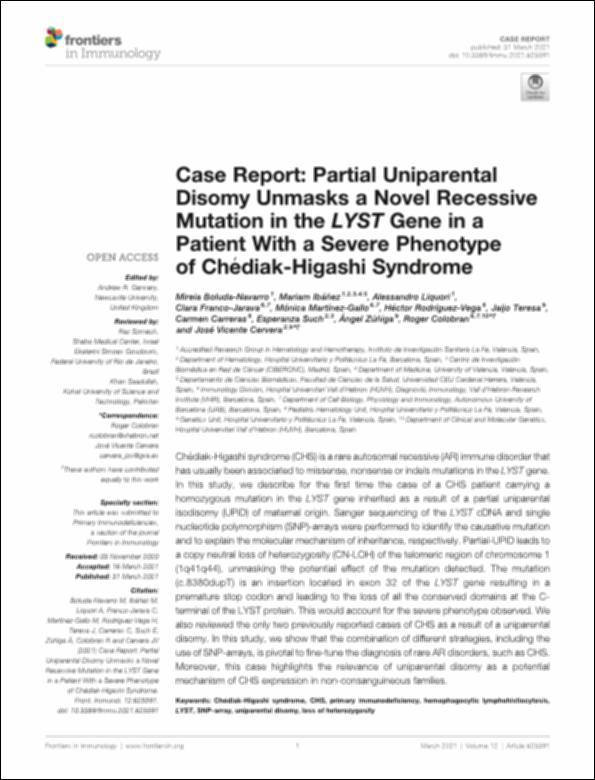Por favor, use este identificador para citar o enlazar este ítem:
http://hdl.handle.net/10637/13653Case report : partial uniparental disomy unmasks a novel recessive mutation in the LYST gene in a patient with a severe phenotype of Chediak-Higashi Syndrome
| Título : | Case report : partial uniparental disomy unmasks a novel recessive mutation in the LYST gene in a patient with a severe phenotype of Chediak-Higashi Syndrome |
| Otros títulos: | Partial uniparental disomy unmasks a novel recessive mutation in the LYST gene in a patient with a severe phenotype of Chediak-Higashi Syndrome |
| Autor : | Boluda Navarro, Mireia Ibáñez Company, Mariam Liquori, Alessandro Franco Javara, Clara Martínez Gallo, Mónica Rodríguez Vega, Héctor |
| Materias: | Béguez-Chédiak-Higashi syndrome - Diagnosis.; Chédiak-Higashi, Síndrome de - Diagnóstico.; Enfermedades genéticas - Diagnóstico.; Chromosome abnormalities.; Sistema inmune - Enfermedades - Diagnóstico.; Immune system - Diseases - Diagnosis.; Anomalías y malformaciones cromosómicas.; Genetic disorders - Diagnosis. |
| Editorial : | Frontiers Media |
| Citación : | Boluda-Navarro, M., Ibáñez, M., Liquori, A., Franco-Jarava, C., Martínez-Gallo, M., Rodríguez-Vega, H. et al. (2021). Case report: partial uniparental disomy unmasks a novel recessive mutation in the LYST gene in a patient with a severe phenotype of Chédiak-Higashi Syndrome. Frontiers in Immunology, vol. 12, art. 625591 (31 mar.). DOI: https://doi.org/10.3389/fimmu.2021.625591 |
| Resumen : | Chédiak-Higashi syndrome (CHS) is a rare autosomal recessive (AR) immune disorder that has usually been associated to missense, nonsense or indels mutations in the LYST gene. In this study, we describe for the first time the case of a CHS patient carrying a homozygous mutation in the LYST gene inherited as a result of a partial uniparental isodisomy (UPiD) of maternal origin. Sanger sequencing of the LYST cDNA and single nucleotide polymorphism (SNP)-arrays were performed to identify the causative mutation and to explain the molecular mechanism of inheritance, respectively. Partial-UPiD leads to a copy neutral loss of heterozygosity (CN-LOH) of the telomeric region of chromosome 1 (1q41q44), unmasking the potential effect of the mutation detected. The mutation (c.8380dupT) is an insertion located in exon 32 of the LYST gene resulting in a premature stop codon and leading to the loss of all the conserved domains at the Cterminal of the LYST protein. This would account for the severe phenotype observed. We also reviewed the only two previously reported cases of CHS as a result of a uniparental disomy. In this study, we show that the combination of different strategies, including the use of SNP-arrays, is pivotal to fine-tune the diagnosis of rare AR disorders, such as CHS. Moreover, this case highlights the relevance of uniparental disomy as a potential mechanism of CHS expression in non-consanguineous families. |
| Descripción : | Este artículo se encuentra disponible en la siguiente URL: https://www.frontiersin.org/articles/10.3389/fimmu.2021.625591/full En este artículo también participan: Jaijo Teresa, Carmen Carreras, Esperanza Such, Ángel Zúñiga, Roger Colobran y José Vicente Cervera. |
| URI : | http://hdl.handle.net/10637/13653 |
| Derechos: | http://creativecommons.org/licenses/by/4.0/deed.es |
| ISSN : | 1664-3224 (Electrónico) |
| Fecha de publicación : | 31-mar-2021 |
| Centro : | Universidad Cardenal Herrera-CEU |
| Aparece en las colecciones: | Dpto. Ciencias Biomédicas |
Los ítems de DSpace están protegidos por copyright, con todos los derechos reservados, a menos que se indique lo contrario.


